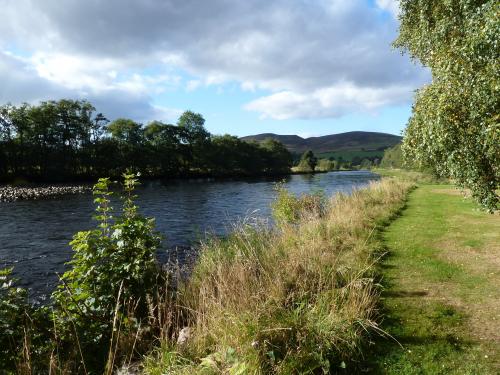River temperature influences biogeochemical processes and aquatic ecology. Sustaining cool river temperatures in Scotland is essential for aquatic ecology (including the habitat and health of Atlantic salmon (Salmo Salar) and brown trout (Salmo trutta). River temperatures are also critical for our economy e.g. sport fishing contributes around £113 million per year to Scottish rural economy and our food and drink industry e.g. whisky production.
Our research has investigated the long-term river temperature changes and its drivers based on a unique 105-year data set of river temperatures from fishing records on the Tulchan Sporting Estate, River Spey (for which we are grateful to the fishing attendants (ghillies) and management at the Tulchan Club, Scotland for collecting and providing the river temperature data). Working with this data set and funded through the Scottish Government, we have shown the river temperatures are warming, especially since the 1960s. These long-term trends can mostly be attributed to air temperature increases related to climate change.

Stage
Directory of Expertise
Purpose
River water temperature influences the habitat, health and survival of salmonids native to Scotland. Sustained high temperatures are of concern for cold water loving brown trout and Atlantic salmon and have wider implications on aquatic ecology. It is well understood that air temperatures have increased over past decades and climate models suggest this trend will continue into the future, thus raising concerns about effects on thermal behaviours of rivers and hence the impact on fish populations.
As the past informs the future, robust assessments of river temperatures in the future requires the collation and investigation of long term observed historical river temperature records which are rare. We analysed a unique data set of river temperatures recorded that were collected on the River Spey on the Tulchan Sporting Estate in Speyside, Moray since 1912.
River temperature data from fishing records at 4 fishing beats of the River Spey (figure modified after Pohle et al. 2019)
Our aim was to identify past long-term changes and their drivers, so the results from this unique study can inform land managers and policy makers about the vulnerability of river temperatures to changing climatic conditions and together we can propose options to enhance the resilience of rivers to changing temperatures.
Results
At James Hutton Institute, we transcribed the river temperature data from fishing records. Together with colleagues at SRUC and BioSS we developed statistical and process-based modelling tools to identify the drivers of variability and long-term changes of river temperature.
Compilation of a data basis of covariates as a prerequisite to model river temperature
We found that river temperature can be predicted from air temperature, cumulative air temperature from beginning of the year, length of the day and runoff. The strongest river temperature increases occurred between 1960 and now with a total increase of around 1.2°C. These changes can be related to air temperature increases of the same magnitude. While total runoff does not show pronounced long-term changes, the contribution of snow melt and its cooling influence on river temperature in spring have declined. For example, the snow free period starts around 7 days earlier per decade after the 1960s.
Long-term warming trends of modelled river temperature at fishing beat D (figure modified after Pohle et al. 2019).
Our analysis of past changes provides:
- important statistically robust evidence that rivers are warming
- and an important baseline for the assessment of future impacts of changing climatic conditions on the thermal regime of rivers.
Benefits
Our study has provided the first long-term evidence that rivers are warming in Scotland. It is important that land managers and policy makers take action to make rivers more resilient to change in the future through the implementation of adaptation measures at catchment scale such as riparian woodland planting, river restoration and controlling abstractions.
The flexible model approach can be applied to other catchments in Scotland and used to inform the strategic direction of catchment management and policy.